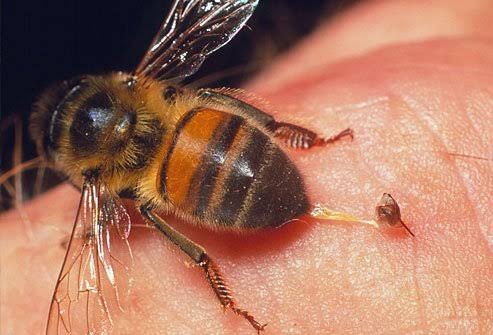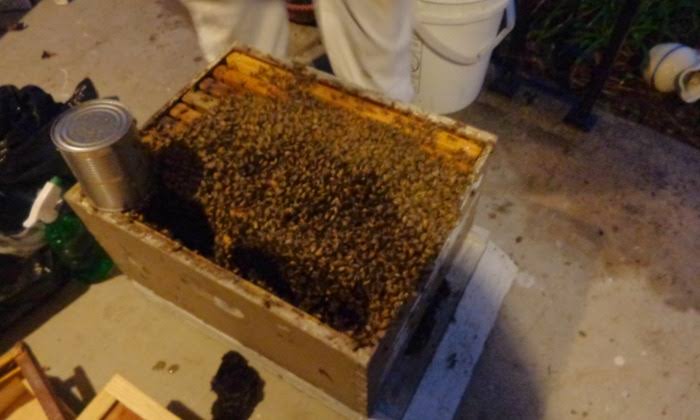Honey bees are generally not aggressive creatures. In fact, most of the time, they go about their buzzing business without bothering anyone. These little insects are more interested in gathering nectar, making honey, and taking care of their hive than causing trouble.
When honey bees do seem aggressive, it’s usually because they are trying to protect their home. Like guardians of a sweet treasure, bees become defensive when they feel their hive is under threat. If you accidentally get too close to their nest or make sudden movements, they might interpret it as a danger signal.
But it’s important to understand that honey bees don’t go looking for trouble. They’re not like some other stinging insects that might attack without much provocation. Bees are more about peace and pollination than picking fights.
If you encounter a bee that seems upset, the best thing to do is stay calm. Panicking and swatting at the bee can make the situation worse. Remember, bees are just doing their job, and they don’t want to sting you. When they do sting, it’s often a last resort because they sacrifice their own lives in the process.
It’s also worth noting that not all bees are created equal when it comes to aggression. Different species of bees have varying temperaments. Honey bees, being social creatures, usually prefer to focus on teamwork rather than aggression.
So, the next time you see a honey bee buzzing around, appreciate the important work it’s doing for nature. They might seem a bit defensive at times, but their intentions are pure – just like the honey they diligently produce for us to enjoy.
In the grand scheme of things, honey bees play a vital role in our ecosystem. Their pollination efforts contribute to the growth of fruits, vegetables, and flowers, ensuring a bountiful harvest for humans and other animals alike. It’s a symbiotic relationship where we benefit from the bees’ hard work, and they, in turn, find sustenance in the nectar they collect.
Understanding the behavior of honey bees helps us coexist harmoniously with these industrious insects. Contrary to the misconception that all bees are out to sting, honey bees are generally gentle, only resorting to defensive measures when they perceive a genuine threat. This defensive instinct is hardwired into their nature as a means of safeguarding their colony and, ultimately, their queen.
The queen bee holds a central role in the hive, as she is responsible for laying eggs and maintaining the colony’s population. The worker bees, predominantly females, tirelessly collect nectar, pollen, and water, contributing to the hive’s sustenance. The male bees, or drones, have a simpler role in the reproductive process.
Interestingly, honey bees communicate with each other through intricate dances, conveying information about the location of food sources and potential threats. This complex communication system allows the colony to function as a unified organism, with each member playing a specific role for the greater good.
Even though honey bees can exhibit defensive behavior, it’s crucial to recognize that they are not out to harm humans without reason. They are simply trying to protect their home and ensure the survival of their colony. As stewards of the environment, we can take steps to appreciate and safeguard these remarkable insects.
In addition, honey bees, despite occasional displays of aggressiveness, are integral to the delicate balance of our ecosystems. By understanding and respecting their nature, we can coexist peacefully, appreciating the sweetness they bring to our world through the golden nectar we know as honey.
Read Also: The Origins of the Apple Fruit
Can Honey Bees Sting?

Yes, honey bees can sting. A honey bee’s sting is a part of its defense mechanism. When a honey bee feels threatened or believes its hive is in danger, it may use its stinger to protect itself and its colony.
The honey bee’s stinger is a needle-like structure that is connected to a venom sac. When the bee stings, the stinger pierces the skin, and the venom is injected into the person or animal. This venom can cause pain, swelling, and sometimes an allergic reaction in some people.
It’s important to note that when a honey bee stings, it loses its stinger along with a part of its abdomen. This means the bee will eventually die after stinging. This sacrifice is a last resort for the honey bee, and it typically occurs when it perceives a significant threat to the hive.
To avoid getting stung by a honey bee, it’s essential to remain calm and move away slowly if you find yourself near a hive. Swatting at the bee or making sudden movements can increase the likelihood of being stung. It’s also helpful to wear light-colored clothing and avoid strong fragrances, as these factors may attract bees.
Despite their ability to sting, honey bees are generally not aggressive and prefer to focus on their vital tasks, such as collecting nectar and pollinating flowers. Understanding and respecting their nature can help foster a peaceful coexistence between humans and these remarkable insects.
Moreover, it’s crucial to recognize that not all honey bees are equally inclined to sting. The worker bees, which are primarily female and responsible for foraging, tend to be the ones that may sting in defense. Male bees, or drones, lack stingers altogether, and the queen bee’s stinger is reserved for duels with rival queens.
The act of stinging is not undertaken lightly by honey bees. It is a measure of last resort, triggered by a genuine perceived threat. The stinging mechanism is a complex process, involving the release of alarm pheromones that signal other bees to be on high alert. This collective defense strategy aims to protect the hive, where the bees work together to ensure the safety of their queen and the entire colony.
While the pain from a honey bee sting can be discomforting, it’s important to note that the venom also contains compounds with potential health benefits. Some people even seek apitherapy, a form of alternative medicine that involves intentional bee stings, believing it may have anti-inflammatory properties.
In the broader context, honey bees play a vital role in the pollination of plants, contributing to the growth of fruits, vegetables, and flowers. The occasional sting, although an unpleasant experience, is a small price to pay for the significant ecological benefits these industrious insects bring to our environment.
However, yes, honey bees can sting, and it’s a natural part of their defense mechanism. Understanding the reasons behind their stinging behavior and taking precautions can help us coexist peacefully with these essential pollinators, ensuring the continued prosperity of both honey bees and the ecosystems they contribute to.
Do Honey Bees Die after Stinging?
Yes, honey bees die after stinging. Unlike other stinging insects, when a honey bee stings, it leaves behind its stinger, along with a part of its abdomen and digestive tract. This self-sacrifice is due to the design of the honey bee’s stinger, which has barbs that embed in the skin, preventing it from being pulled out easily.
As the honey bee pulls away after stinging, the stinger and attached abdominal tissue are left behind, causing injury to the bee. This leads to the bee’s eventual death, typically within a short time after the sting.
This unique stinging mechanism is specific to honey bees and is not shared by all stinging insects. It serves as a last-resort defense mechanism to protect the hive and is activated when the bee perceives a significant threat. Understanding this behavior highlights the importance of approaching honey bees with care and respect to avoid unnecessary harm to these crucial pollinators.
Read Also: How to increase Passion Fruit Yields
How to Buy Honey Bees

Buying honey bees typically involves acquiring a bee colony or a package of bees for beekeeping purposes. Here are a few general steps to consider:
1. Research Local Regulations: Check local regulations and requirements for beekeeping in your area. Some places may have specific rules or permits related to keeping honey bees.
2. Find Reputable Suppliers: Look for reputable bee suppliers or apiaries in your region. Local suppliers are often preferred to ensure that the bees are adapted to your specific climate.
3. Choose the Right Bees: Decide whether you want to purchase a full colony (including a queen, worker bees, and drones) or a package of bees (usually containing worker bees and a mated queen).
4. Consider Bee Species: Different bee species, such as Italian, Carniolan, or Buckfast, have unique characteristics. Research and choose a species that aligns with your beekeeping goals and local conditions.
5. Order in Advance: Bee packages and colonies are often in high demand, especially in the spring. Plan ahead and order in advance to secure your bees.
6. Prepare Beekeeping Equipment: Ensure you have the necessary beekeeping equipment, including hive boxes, frames, protective gear (such as a bee suit and gloves), and tools.
7. Provide a Suitable Hive: Set up a hive with frames for the bees to build comb. Make sure it’s located in a suitable area with access to food sources.
8. Pick Up or Receive Shipment: Depending on the supplier, you may need to pick up the bees or have them shipped to your location. Follow the supplier’s instructions for introducing the bees to their new hive.
9. Monitor and Care for Bees: Regularly monitor the hive, provide necessary care, and learn about beekeeping practices to ensure the health and productivity of your honey bee colony.
Always prioritize ethical and humane treatment of bees, and consider joining local beekeeping associations or seeking advice from experienced beekeepers to enhance your knowledge and skills.
Remove Honey Bees
If you are facing an issue with honey bees and need them removed, it’s important to approach the situation with care and consideration for both the bees and your own safety. Here are some steps to consider:
1. Identify the Species: Determine whether the bees are honey bees or another type of bee or wasp. Honey bees are crucial pollinators, and efforts should be made to preserve them if possible.
2. Contact a Beekeeper: Reach out to local beekeepers or beekeeping associations. Many beekeepers are experienced in safely removing and relocating honey bee colonies. They may be willing to assist, especially if the bees are honey bees.
3. Professional Bee Removal Services: Consider hiring a professional bee removal service. Some pest control companies specialize in live bee removal, focusing on relocating the bees rather than extermination.
4. Avoid DIY Approaches: Avoid attempting to remove the bees yourself, especially if you are not experienced in beekeeping. Honey bees can become aggressive when they feel threatened, leading to potential stinging incidents.
5. Prevent Attraction: Address the factors attracting bees, such as food sources or open containers of sweet substances. Taking away the attraction might encourage the bees to move on naturally.
6. Seal Entry Points: If the bees have made a nest in an unwanted location, consider sealing potential entry points to discourage them from returning.
7. Local Regulations: Be aware of local regulations regarding bee removal. Some areas may have specific guidelines or restrictions on the removal of honey bee colonies.
Remember that honey bees are valuable pollinators, and their decline poses a threat to ecosystems. Whenever possible, it’s recommended to choose solutions that allow for the safe relocation of honey bee colonies rather than extermination. If you’re uncertain about the best course of action, seeking advice from local beekeeping experts or authorities can be helpful.
